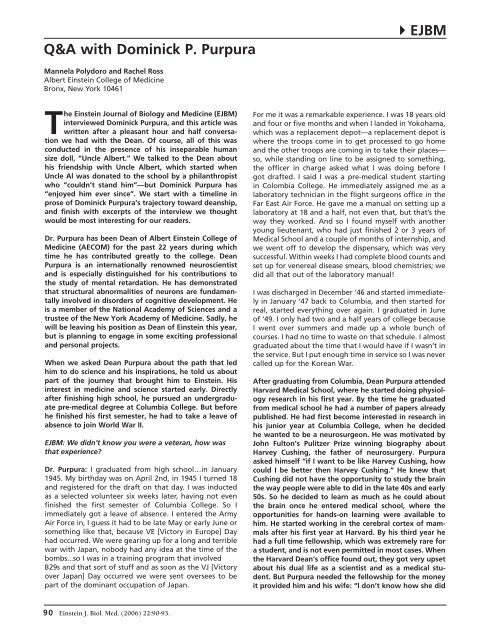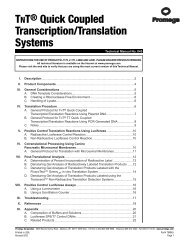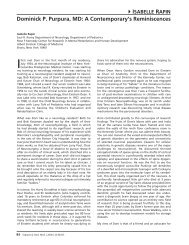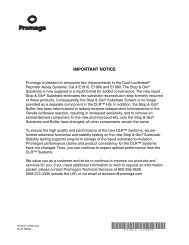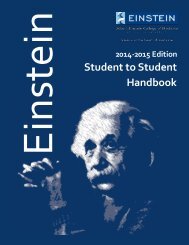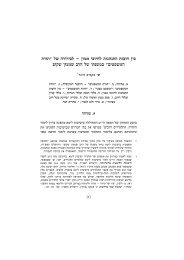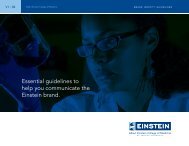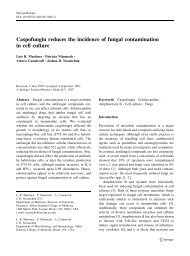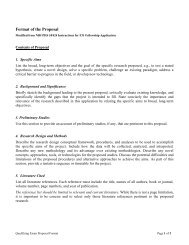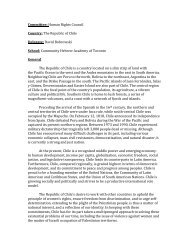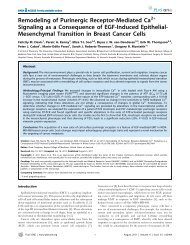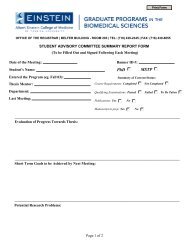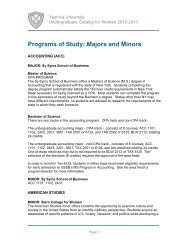Q&A with Dominick P. Purpura - Albert Einstein College of Medicine
Q&A with Dominick P. Purpura - Albert Einstein College of Medicine
Q&A with Dominick P. Purpura - Albert Einstein College of Medicine
- No tags were found...
You also want an ePaper? Increase the reach of your titles
YUMPU automatically turns print PDFs into web optimized ePapers that Google loves.
Q&A <strong>with</strong> <strong>Dominick</strong> P. <strong>Purpura</strong>4EJBMMannela Polydoro and Rachel Ross<strong>Albert</strong> <strong>Einstein</strong> <strong>College</strong> <strong>of</strong> <strong>Medicine</strong>Bronx, New York 10461The <strong>Einstein</strong> Journal <strong>of</strong> Biology and <strong>Medicine</strong> (EJBM)interviewed <strong>Dominick</strong> <strong>Purpura</strong>, and this article waswritten after a pleasant hour and half conversationwe had <strong>with</strong> the Dean. Of course, all <strong>of</strong> this wasconducted in the presence <strong>of</strong> his inseparable humansize doll, “Uncle <strong>Albert</strong>.” We talked to the Dean abouthis friendship <strong>with</strong> Uncle <strong>Albert</strong>, which started whenUncle Al was donated to the school by a philanthropistwho “couldn’t stand him”—but <strong>Dominick</strong> <strong>Purpura</strong> has“enjoyed him ever since”. We start <strong>with</strong> a timeline inprose <strong>of</strong> <strong>Dominick</strong> <strong>Purpura</strong>’s trajectory toward deanship,and finish <strong>with</strong> excerpts <strong>of</strong> the interview we thoughtwould be most interesting for our readers.Dr. <strong>Purpura</strong> has been Dean <strong>of</strong> <strong>Albert</strong> <strong>Einstein</strong> <strong>College</strong> <strong>of</strong><strong>Medicine</strong> (AECOM) for the past 22 years during whichtime he has contributed greatly to the college. Dean<strong>Purpura</strong> is an internationally renowned neuroscientistand is especially distinguished for his contributions tothe study <strong>of</strong> mental retardation. He has demonstratedthat structural abnormalities <strong>of</strong> neurons are fundamentallyinvolved in disorders <strong>of</strong> cognitive development. Heis a member <strong>of</strong> the National Academy <strong>of</strong> Sciences and atrustee <strong>of</strong> the New York Academy <strong>of</strong> <strong>Medicine</strong>. Sadly, hewill be leaving his position as Dean <strong>of</strong> <strong>Einstein</strong> this year,but is planning to engage in some exciting pr<strong>of</strong>essionaland personal projects.When we asked Dean <strong>Purpura</strong> about the path that ledhim to do science and his inspirations, he told us aboutpart <strong>of</strong> the journey that brought him to <strong>Einstein</strong>. Hisinterest in medicine and science started early. Directlyafter finishing high school, he pursued an undergraduatepre-medical degree at Columbia <strong>College</strong>. But beforehe finished his first semester, he had to take a leave <strong>of</strong>absence to join World War II.EJBM: We didn’t know you were a veteran, how wasthat experience?Dr. <strong>Purpura</strong>: I graduated from high school…in January1945. My birthday was on April 2nd, in 1945 I turned 18and registered for the draft on that day. I was inductedas a selected volunteer six weeks later, having not evenfinished the first semester <strong>of</strong> Columbia <strong>College</strong>. So Iimmediately got a leave <strong>of</strong> absence. I entered the ArmyAir Force in, I guess it had to be late May or early June orsomething like that, because VE [Victory in Europe] Dayhad occurred. We were gearing up for a long and terriblewar <strong>with</strong> Japan, nobody had any idea at the time <strong>of</strong> thebombs...so I was in a training program that involvedB29s and that sort <strong>of</strong> stuff and as soon as the VJ [Victoryover Japan] Day occurred we were sent oversees to bepart <strong>of</strong> the dominant occupation <strong>of</strong> Japan.For me it was a remarkable experience. I was 18 years oldand four or five months and when I landed in Yokohama,which was a replacement depot—a replacement depot iswhere the troops come in to get processed to go homeand the other troops are coming in to take their places—so, while standing on line to be assigned to something,the <strong>of</strong>ficer in charge asked what I was doing before Igot drafted. I said I was a pre-medical student startingin Colombia <strong>College</strong>. He immediately assigned me as alaboratory technician in the flight surgeons <strong>of</strong>fice in theFar East Air Force. He gave me a manual on setting up alaboratory at 18 and a half, not even that, but that’s theway they worked. And so I found myself <strong>with</strong> anotheryoung lieutenant, who had just finished 2 or 3 years <strong>of</strong>Medical School and a couple <strong>of</strong> months <strong>of</strong> internship, andwe went <strong>of</strong>f to develop the dispensary, which was verysuccessful. Within weeks I had complete blood counts andset up for venereal disease smears, blood chemistries; wedid all that out <strong>of</strong> the laboratory manual!I was discharged in December ‘46 and started immediatelyin January ‘47 back to Columbia, and then started forreal, started everything over again. I graduated in June<strong>of</strong> ‘49. I only had two and a half years <strong>of</strong> college becauseI went over summers and made up a whole bunch <strong>of</strong>courses. I had no time to waste on that schedule. I almostgraduated about the time that I would have if I wasn’t inthe service. But I put enough time in service so I was nevercalled up for the Korean War.After graduating from Columbia, Dean <strong>Purpura</strong> attendedHarvard Medical School, where he started doing physiologyresearch in his first year. By the time he graduatedfrom medical school he had a number <strong>of</strong> papers alreadypublished. He had first become interested in research inhis junior year at Columbia <strong>College</strong>, when he decidedhe wanted to be a neurosurgeon. He was motivated byJohn Fulton’s Pulitzer Prize winning biography aboutHarvey Cushing, the father <strong>of</strong> neurosurgery. <strong>Purpura</strong>asked himself “if I want to be like Harvey Cushing, howcould I be better then Harvey Cushing.” He knew thatCushing did not have the opportunity to study the brainthe way people were able to did in the late 40s and early50s. So he decided to learn as much as he could aboutthe brain once he entered medical school, where theopportunities for hands-on learning were available tohim. He started working in the cerebral cortex <strong>of</strong> mammalsafter his first year at Harvard. By his third year hehad a full time fellowship, which was extremely rare fora student, and is not even permitted in most cases. Whenthe Harvard Dean’s <strong>of</strong>fice found out, they got very upsetabout his dual life as a scientist and as a medical student.But <strong>Purpura</strong> needed the fellowship for the moneyit provided him and his wife: “I don’t know how she did90 <strong>Einstein</strong> J. Biol. Med. (2006) 22:90-93.
Q&A <strong>with</strong> <strong>Dominick</strong> P. <strong>Purpura</strong>4EJBMit but we got pregnant. It was devastating! Things likethat were horrendous on our economics, so I neededthat fellowship. So the deal I made <strong>with</strong> the chairman <strong>of</strong>Physiology, a very distinguished man, was that I woulddo B or better in every course in order to keep workingin the laboratory. And I didn’t have any problem; I graduatedmagna cum laude.”After getting his medical degree from Harvard in 1953,<strong>Purpura</strong> went back to Columbia for his residency in neurosurgery.During that time he organized a laboratory inthe Department <strong>of</strong> Neurosurgery to carry on research,and that led to him full-time research work. “I am alwaysproud <strong>of</strong> the fact that when I had that laboratory, thefirst student that I ever took into my laboratory was EricKandel, Nobel Laureate in 2000. He and I constantly jokeabout the kind <strong>of</strong> fun that we had then.”Dr. <strong>Purpura</strong> was recruited to <strong>Einstein</strong> in the summer <strong>of</strong>1966 to teach neurophysiology and neuroanatomy. Hestarted at <strong>Einstein</strong> on January 2, 1967 as Chairman <strong>of</strong> theDepartment <strong>of</strong> Anatomy <strong>with</strong> the charge <strong>of</strong> developinga program about the nervous system for the medicalschool curriculum. At the same time, AECOM decidedto overhaul its entire curriculum. The Dean at the time,Harry Gordon, appointed Dr. <strong>Purpura</strong> as chairman <strong>of</strong> thecurriculum committee, whose plan was to shorten thehours students spent in anatomy, histology, physiology,and pharmacology labs in order to give them more timeto be involved in other activities. Dr. <strong>Purpura</strong> credits SamRosen, the Associate Dean for Students, <strong>with</strong> helpinghim come up <strong>with</strong> the novel fusion course in pathophysiology,which revolutionized medical curricula at the time.It was during this revision that Dr. <strong>Purpura</strong> organized theintegrative course in neurobiology, which continues tothis day. It was the first <strong>of</strong> the so-called “megacourses”and he taught the bulk <strong>of</strong> it during his time as a pr<strong>of</strong>essorat AECOM. The other major revision made by thecommittee was the start <strong>of</strong> the Family Life Program,which assigned first year medical students to a mentorphysician and a family to follow their health needs forthe duration <strong>of</strong> their medical education.In 1969, Dom was appointed Scientific Director, then in1972 Director, <strong>of</strong> the Rose F. Kennedy Center for Researchin Mental Retardation and Human Development, thoughhe still maintained the chairmanship in the Department<strong>of</strong> Anatomy. Being Director <strong>of</strong> the Kennedy Center wasa huge job that could have been split into two parts.One part was to run the already existing research centerand the other was to develop a neuroscience programfor cutting-edge research. In 1974, <strong>Purpura</strong> founded theDepartment <strong>of</strong> Neuroscience and stepped down from thechair <strong>of</strong> the Anatomy Department.Dr. <strong>Purpura</strong> directed the Kennedy Center from 1972 to1982, after which he left for the Stanford UniversitySchool <strong>of</strong> <strong>Medicine</strong> to be the Dean and Associate VicePresident for Medical Affairs. This position was shortlived,“I had two and a half years <strong>of</strong> what I refer to asmy ‘Dean Sabbatical.’” In the middle <strong>of</strong> 1984 he cameback to AECOM as Dean, a position he has commandedfor nearly 22 years, as the longest running dean in thecountry. Dr. <strong>Purpura</strong> has been at <strong>Einstein</strong> for a total <strong>of</strong>nearly 36 years, and much <strong>of</strong> our acclaim as a school <strong>of</strong>medicine can be attributed to his great leadership andcontributions to shape this community.Below is the rest <strong>of</strong> our interview <strong>with</strong> Dr. <strong>Purpura</strong>,which includes his thoughts on the medical and scientificcurricula, his plans for the future, his advice to students,and some little known facts about his life outside <strong>of</strong><strong>Einstein</strong>. Enjoy our conversation <strong>with</strong> the Dean!EJBM: Of all your work, what do you think is yourgreatest contribution?Dr. <strong>Purpura</strong>: For the medical school, I think the importantthings that have happened over the past two decades has[sic] been the establishment <strong>of</strong> a system for empoweringthe faculty…in the design <strong>of</strong> the curriculum, in theorganization <strong>of</strong> courses, and in the evaluation system,which I then formalized 10 years ago in the Division<strong>of</strong> Education (DOE). Through the implementation andorganizational skills <strong>of</strong> Al Kuperman we have been ableto develop a very important program for the medicaleducation here, which isn’t unique, but from our standpoint,the most important thing, and the one thing I amproudest <strong>of</strong>, is that when our students leave here theyare prepared for engaging an internship, residency, anddoing the things that are necessary to become fine house<strong>of</strong>ficers. I’ve heard this repeatedly, that the training ourstudents get is just outstanding. In order to do that it isnot only necessary to provide the integrated courses thatare now part <strong>of</strong> the pre-clinical years; but we also buildin this period a good safety net for student clerkships. So,in addition to Montefiore, which has been our primaryaffiliate, we continue to work <strong>with</strong> Jacobi Hospital andBronx-Lebanon. We developed new relationships, newaffiliations <strong>with</strong> Beth Israel Medical Center and the NorthShore Long Island Jewish Medical Center. So, the variety<strong>of</strong> experiences that students get at these various sites andthe patient mix is, I think, one <strong>of</strong> the important thingsabout the education here that’s outstanding.I think those are accomplishments. I think the strengthening<strong>of</strong> the MD/PhD program has been important. Thegraduate program is in good shape. We had paid particularattention to the needs <strong>of</strong> the post-doctoral fellows byproviding greater opportunities for housing and benefits,and those are the things that post-doctoral fellows arevery much concerned about. The post-doctoral fellowsdon’t seem to have a continuing amount <strong>of</strong> irritationas a group; they are content. The graduate studentsare well cared for. So, student programs are going well.The affiliates are very happy to have our students becauseit enhances their capacity to recruit good faculty asThe <strong>Einstein</strong> Journal <strong>of</strong> Biology and <strong>Medicine</strong> 91
Q&A <strong>with</strong> <strong>Dominick</strong> P. <strong>Purpura</strong>4EJBMwell as good residents. So it is a very mutually beneficialrelationship.Now, we are, even to self advertisement, a very researchintensive medical school. Research is a very very importantpart <strong>of</strong> our lives. The maintenance <strong>of</strong> a strong program<strong>with</strong> the National Institutes <strong>of</strong> Health (NIH) is whatmakes us tick.I have recruited every one <strong>of</strong> the chairs in the basicscience and, sometimes, two or three times. We haverecruited outstanding leaders who are able to identifyexcellent young faculty, many <strong>of</strong> whom over the years Ihave seen come from the ranks <strong>of</strong> assistant pr<strong>of</strong>essor upto chairman. Tremendous statement <strong>of</strong> loyalty as a result<strong>of</strong> that, that’s what it really represents. Excellent peoplethat have become part <strong>of</strong> the faculty here. Our basic scienceprogram over the years, and even before my beingDean, was always excellent. From the standpoint <strong>of</strong> theNIH, we generally were in the top 5 <strong>of</strong> NIH monies inbasic sciences, and we stayed very much at that level.Considering the amount <strong>of</strong> competition and growth inother institutions, I think that’s something that this institutionshould be proud <strong>of</strong>.At some point about almost seven, eight years ago, twothoughts occurred to me. First, we absolutely had tohave a new building, the faster the better, even thoughit’s taken this long time to get this building to this stage.And, secondly, we had to expand our interest much morefrom basic science to a more clinical investigation andclinical research oriented work. That’s why I coined theterm “A Center for Genetic and Translational <strong>Medicine</strong>.”At the time, the word translational had not been usedthat much, seven years ago, and we dubbed that, putthat name on the building and now so many institutionsnow use that word. It’s the buzzword, the word <strong>of</strong> theday.My definition <strong>of</strong> translational research is translating thebasic science <strong>of</strong> medicine to the science <strong>of</strong> patient care.And, <strong>of</strong> course, <strong>with</strong>out throwing out the heart <strong>of</strong> medicine,but we are talking about the science <strong>of</strong> medicinetoday, both in terms <strong>of</strong> genomic medicine, drug discovery,proteomics, epigenomics, the whole works is part <strong>of</strong> thefuture. So this building comes at just the right time to beat the leading edge <strong>of</strong> where medical science is going andbehavioral science is going.EJBM: Who was the most influential person in thehistory <strong>of</strong> AECOM?Dr. <strong>Purpura</strong>: I would put down the two “Harrys”. One isHarry Eagle, who passed away some years ago. He was anextraordinary scientist and administrator. He began in theearly years to build the scientific base <strong>of</strong> AECOM. HarryEagle was a person that one would want to emulate. Hewas associate dean for scientific affairs, before me, aswell for the previous dean, he was one <strong>of</strong> the brightestand most gifted administrators in science in the country.The other person I would like to put down is HarryGordon, who was the dean who appointed me to becomethe scientific director and then director <strong>of</strong> the KennedyCenter. His career was in pediatrics. His warmth and hisexpression for the advocacy for patients, for children inparticular, were very important to me.EJBM: Where do you see AECOM in the next 10 years?Dr. <strong>Purpura</strong>: I think we have searched for and found anexcellent person in Allen Spiegel, the next Dean. He hasa superb scientific background and excellent administrativecapabilities. So I think we are going to have someonewho is going to make a major impact as a leaderin American medicine. And he’s at a good place to do itbecause the medical school is in a very facilitating role inmedical science. Its educational programs are secure, itsbuilding program is excellent, and I think that the creativity<strong>of</strong> the faculty is going to keep bringing one advanceafter another, both in terms <strong>of</strong> management, drug discovery,epidemiology. And also by bringing together bioinformatics<strong>with</strong> computational sciences, which is the nextarea <strong>of</strong> great importance. And so that’s secure.I think it is important to recognize that our Board <strong>of</strong>Overseers plays a very important role in developing, <strong>with</strong>the Dean, and <strong>with</strong> the administration and the faculty,programs for expansion and providing the philanthropicthrust that is needed to supplement NIH activity. Theextramural sources are one thing, but the philanthropy inthis institution is vital. The generator <strong>of</strong> that is our Board<strong>of</strong> Overseers, the university’s interest and desire, as wellas ability to implement programs that bring funding intothe medical school. The new president is very dedicatedto the continuing and developing excellence <strong>of</strong> the medicalschool. So that in his fundraising we are not far fromhis thoughts, and that’s critical. You can have a presidentthat is so concerned about his or her own thing, but thismedical is school is, we like to use the expression, “TheCrown Jewel” in the crown <strong>of</strong> Yeshiva University. I don’tthink there’s any contention about that.EJBM: What are you planning to do post-retirement?Dr. <strong>Purpura</strong>: Well I am not retiring. I have got to get backto the Kennedy center, for one thing. I am looking forwardto picking up in several areas <strong>of</strong> interest that I wasinvolved <strong>with</strong> many years ago which have become veryimportant areas <strong>of</strong> research, such as the role <strong>of</strong> dendritesand dendritic spines, their structure and function. I wantto look at some <strong>of</strong> the issues in the curriculum <strong>of</strong> thehuman nervous system course.92 EJBM, Copyright © 2006
Q&A <strong>with</strong> <strong>Dominick</strong> P. <strong>Purpura</strong>4EJBMEJBM: You will still be here every day?Dr. <strong>Purpura</strong>: Yeah, between here and probably someother institution that I am going to be visiting. And I’malways available for any kind <strong>of</strong> questions that peoplewant to ask.EJBM: Who would you like to thank for your accomplishments?Dr. <strong>Purpura</strong>: My wife. I couldn’t have gotten here <strong>with</strong>outher support, and to share my support to her. We have avery exciting and interesting partnership.EJBM: When you say going back to Kennedy, do youmean doing research?Dr. <strong>Purpura</strong>: I won’t have a laboratory. I’ve been away fortoo long. But having spent a long period <strong>of</strong> time as editor<strong>of</strong> the Brain Research Journals, I have kept up <strong>with</strong> thefield and hope to use that information for several reviewsthat I want to do, particularly in the area <strong>of</strong> structure andfunction <strong>of</strong> dendritic systems.I hope to do that. I hope to become more pr<strong>of</strong>icient inpracticing for longer periods <strong>of</strong> time my cello.EJBM: How long have you been playing the cello?Dr. <strong>Purpura</strong>: A very short period <strong>of</strong> time—that’s my problem!About a year and a couple months. I picked it up bymyself unfortunately. I am the worst teacher you couldimagine. But I had experience when I was a child playingthe violin. Currently I am working <strong>with</strong> my daughter-inlawon a Bach.EJBM: How did you meet your wife?Dr. <strong>Purpura</strong>: We met in the latter part <strong>of</strong> ‘46, or maybeearly ‘47 at the YWCA on 53rd street and Lexingtonavenue, at a dance, at a Saturday night dance. And that’show we met. As my wife Penny says, the rest <strong>of</strong> it is history.We got married in 1948, while I was just enteringmy senior year at Columbia <strong>College</strong>. We have 58 years, apretty successful marriage. We have learned a lot abouteach other and how to make things work, which is veryimportant.I’ve had considerable longevities, it’s interesting, in mylife. My marriage, these 22 years as Dean, I was editor inchief <strong>of</strong> Brain Research for 27 years. I was the founder <strong>of</strong>four Brain Research Journals: Molecular Brain Research,Development Brain Research, Cognitive Brain Researchand Brain Research Reviews, all the family spin-<strong>of</strong>fs <strong>of</strong>Brain Research. My other longevity was president <strong>of</strong>International Brain Research Organization (IBRO) which,at that time had about 70,000 neuroscientist members inthe world. I stayed 12 years as president.EJBM: That does not look simple at all. That is impressive,in a year and a half that is quite amazing!Dr. <strong>Purpura</strong>: Actually, it gets done. It just sounds terrible!Intonation is the enemy <strong>of</strong> the amateur. I don’t have anyproblems <strong>with</strong> the reading. My daughter-in-law is verygood at the violin. She has played <strong>with</strong> several interestingquartets while she was at Rockefeller. She is a greatteacher.EJBM: What are you most proud <strong>of</strong> in life?Dr. <strong>Purpura</strong>: The accomplishments <strong>of</strong> my children. My firstson works at IBM, my second son is a Captain, he flies atAmerican Eagle Airlines. My third son is a neuroscientistdown at Cornell, he has a PhD, and his wife is also aneuroscientist. My daughter, the youngest, is a PhD in culturalanthropology, East African cultural anthropology.I am also proud that students are prepared for medicallife beyond <strong>Einstein</strong>. I am happy to think that when peopleget sick there are exceptionally smart doctors around<strong>with</strong> outstanding skills which they will use to save lives.It has been wonderful to be involved in handing out 200diplomas per year. I am extremely proud to have givenout more than 4000 diplomas here at <strong>Einstein</strong>.EJBM: What have you learned as Dean?Dr. <strong>Purpura</strong>: As Dean, I have learned that you will be successfulto the extent that you lead the faculty in the directionthey want to go but don’t know how to get there.I would advise the medical students to cherish everymoment <strong>of</strong> the experience they have being a studentand an MD. We are privileged to take on responsibilitiesafforded to no other individual—that is to care for ourfellow human beings. I hear students say “I came out <strong>of</strong>school and I don’t know anything and now I am in charge<strong>of</strong> someone’s grandmother.” It is true, they get a 007license to kill and cure which is a great responsibility thatshould be used very carefully. For the PhD’s I would saythat the key to success in science is experimentation.There is this <strong>Einstein</strong> quote which is one <strong>of</strong> my favoritesthat says “It is the responsibility <strong>of</strong> every human being toaspire to do something worthwhile, to make the world abetter place than the one we found. Life is a gift, and ifwe agree to accept it, we must contribute in return.” Inthe end, when they sum up, people should ask themselvesif they did something worthwhile. Having the opportunitiesfor it, everyone should help the human condition andtry to make things better.The <strong>Einstein</strong> Journal <strong>of</strong> Biology and <strong>Medicine</strong> 93


